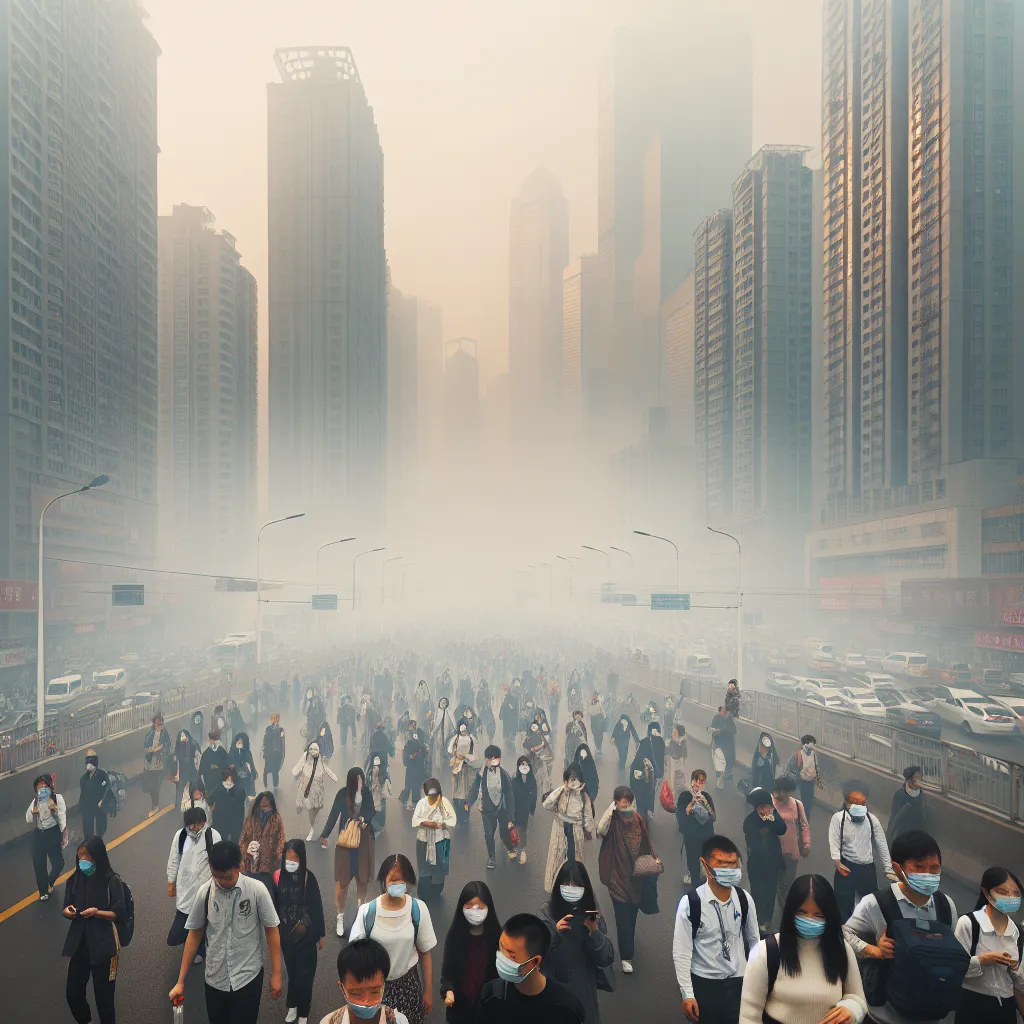Air pollution is a pressing global issue that affects many cities and regions worldwide. As such, it’s a topic that frequently appears in IELTS Speaking tests. This article will guide you through answering questions about places affected by air pollution, helping you achieve a high band score in your IELTS Speaking exam.
Nội dung bài viết
Understanding the Topic
Before we dive into the specifics, it’s important to understand why this topic is relevant to IELTS. Environmental issues, including air pollution, are common themes in IELTS exams as they reflect real-world concerns and test candidates’ ability to discuss complex topics.
Part 1: Introduction and Interview
In Part 1, the examiner may ask you general questions about air pollution. Here are some possible questions and sample answers:
Q: Do you think air pollution is a serious problem in your city?
Band 6-7 Answer: Yes, I believe air pollution is quite a serious issue in my city. We often see smog, especially during rush hours, and it can be quite uncomfortable to breathe sometimes.
Band 8-9 Answer: Absolutely. Air pollution has become an increasingly pressing concern in my city. The prevalence of smog, particularly during peak traffic hours, is not only visually apparent but also poses significant health risks to residents. The air quality often reaches hazardous levels, which is especially dangerous for vulnerable groups like children and the elderly.
Part 2: Long Turn
Here’s a sample cue card related to the topic:
Describe a place you have visited that is affected by air pollution
You should say:
- Where the place is
- When you visited it
- What you saw there
- And explain how air pollution has affected this place
Sample Answer (Band 8-9)
I’d like to talk about Beijing, the capital city of China, which I visited two years ago during summer. Beijing is notorious for its severe air pollution, and my experience there was quite eye-opening.
Upon arriving, I was immediately struck by the thick, greyish haze that blanketed the city. The sky, which should have been a clear blue, was instead a murky, almost opaque shade. This smog was so dense that it was often difficult to see buildings just a few blocks away, giving the city an almost apocalyptic atmosphere.
During my stay, I noticed that many locals wore face masks as part of their daily attire, which was a stark reminder of the air quality crisis. Even famous landmarks like the Forbidden City and Tiananmen Square were partially obscured by the pollution, significantly impacting the tourist experience.
The air pollution has profoundly affected Beijing in numerous ways. Firstly, it has created serious health concerns for residents, with respiratory issues becoming increasingly common. Secondly, it has impacted the city’s economy and tourism, as some visitors are deterred by the poor air quality. Lastly, it has forced the government to implement strict measures to combat pollution, such as limiting car usage and closing factories on high pollution days.
My visit to Beijing was a sobering experience that highlighted the urgent need for global action on air pollution. It demonstrated how environmental issues can dramatically alter the fabric of a city and the daily lives of its inhabitants.
Examiner’s Follow-up Questions
Q: How do you think air pollution affects people’s daily lives in such cities?
Band 6-7 Answer: Air pollution can make people feel uncomfortable and unhealthy. They might need to wear masks when going outside and may prefer to stay indoors on bad days. It can also affect outdoor activities and tourism.
Band 8-9 Answer: Air pollution has a pervasive impact on daily life in affected cities. It significantly alters people’s routines and behaviors. Residents often need to check air quality indexes before venturing outdoors and may limit their exposure by staying inside on particularly polluted days. The need to wear protective masks becomes a daily consideration, affecting everything from commuting to social interactions. Moreover, it can lead to the cancellation of outdoor events and school activities, disrupting normal city life. Long-term exposure can result in chronic health issues, increasing healthcare costs and reducing overall quality of life.
 Beijing air pollution
Beijing air pollution
Part 3: Two-way Discussion
In this part, the examiner will ask more abstract questions related to air pollution. Here are some sample questions and answers:
Q: What do you think are the main causes of air pollution in cities?
Band 6-7 Answer: I think the main causes are probably vehicle emissions, factory smoke, and construction dust. In big cities, there are so many cars and factories, which produce a lot of pollution.
Band 8-9 Answer: The primary contributors to urban air pollution are multifaceted and interconnected. Vehicular emissions are a significant factor, particularly in cities with inadequate public transportation systems, leading to high private car usage. Industrial activities, especially those involving fossil fuel combustion, release substantial amounts of pollutants. Construction and demolition work also plays a role, generating particulate matter. Additionally, energy production, especially from coal-fired power plants, is a major source of air pollutants. It’s also worth noting that in some regions, agricultural practices such as crop burning can exacerbate urban air pollution. These factors are often compounded by geographical and meteorological conditions, such as cities located in valleys where pollutants can become trapped.
Q: How can governments and individuals work together to reduce air pollution?
Band 6-7 Answer: Governments can make stricter laws about pollution and invest in clean energy. Individuals can use public transport more and try to save energy at home. If everyone does their part, it can make a big difference.
Band 8-9 Answer: Tackling air pollution requires a collaborative approach between governments and individuals. Governments can implement comprehensive policies such as enforcing stricter emission standards for industries and vehicles, investing in renewable energy sources, and improving public transportation infrastructure. They can also offer incentives for green technologies and sustainable practices.
Individuals, on their part, can make conscious lifestyle choices such as opting for public transport or carpooling, reducing energy consumption at home, and supporting eco-friendly products. They can also participate in community initiatives like tree planting or local clean-air campaigns.
Education and awareness play a crucial role in this partnership. Governments can launch public information campaigns about the impacts of air pollution and ways to reduce it, while individuals can educate themselves and others about sustainable practices.
Ultimately, effective change comes from a combination of top-down policy measures and bottom-up individual actions, creating a synergistic effect in the fight against air pollution.
Key Vocabulary and Phrases
To achieve a high band score, use these advanced vocabulary items and phrases:
-
Notorious (adjective) /nəʊˈtɔː.ri.əs/ – famous for something bad
Example: The city is notorious for its high levels of air pollution. -
Pervasive (adjective) /pəˈveɪ.sɪv/ – spreading widely throughout an area or group of people
Example: The pervasive smog affected visibility across the entire city. -
Apocalyptic (adjective) /əˌpɒk.əˈlɪp.tɪk/ – describing or prophesying the complete destruction of the world
Example: The thick pollution gave the city an almost apocalyptic atmosphere. -
Exacerbate (verb) /ɪɡˈzæs.ə.beɪt/ – to make something that is already bad even worse
Example: The recent heatwave has exacerbated the air pollution problem. -
Multifaceted (adjective) /ˌmʌl.tiˈfæs.ɪ.tɪd/ – having many different aspects or features
Example: Air pollution is a multifaceted issue requiring a comprehensive approach.
Examiner’s Advice
To excel in the IELTS Speaking test when discussing air pollution:
- Develop your vocabulary: Learn and use topic-specific terms related to environment and pollution.
- Practice describing visual pollution: Be prepared to vividly describe smog, haze, and their effects on landscapes.
- Stay informed: Keep up-to-date with current environmental issues and policies to provide relevant examples.
- Use personal experiences: If possible, relate the topic to your own observations or experiences for authenticity.
- Structure your answers: Organize your thoughts logically, especially in Part 2, to ensure a coherent response.
Remember, the key to a high score is not just about what you say, but how you say it. Aim for fluency, coherence, and a range of vocabulary and grammatical structures in your responses.
For more practice on describing places, you might find it helpful to check out this guide on describing famous places you’ve visited. While the focus is different, many of the descriptive techniques can be applied to discussing places affected by air pollution as well.


